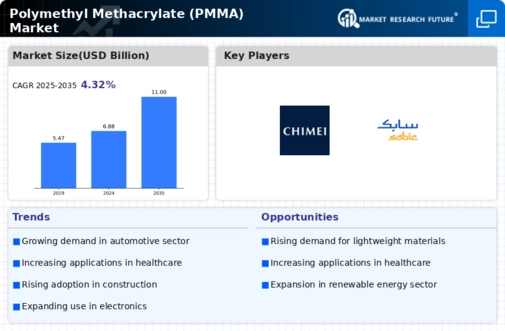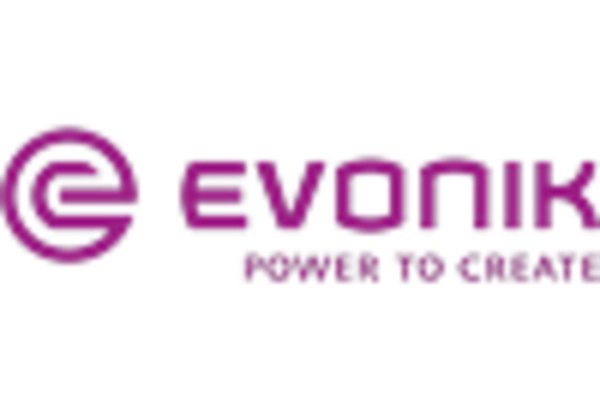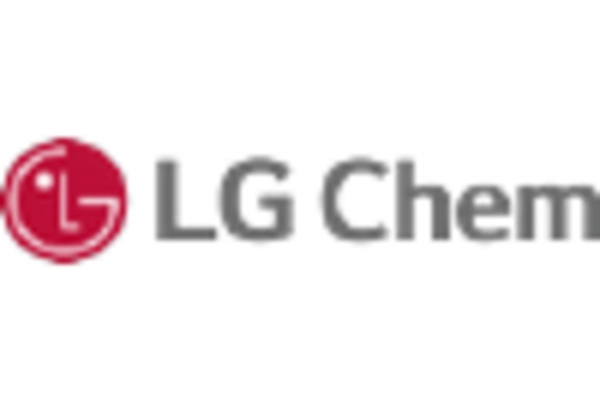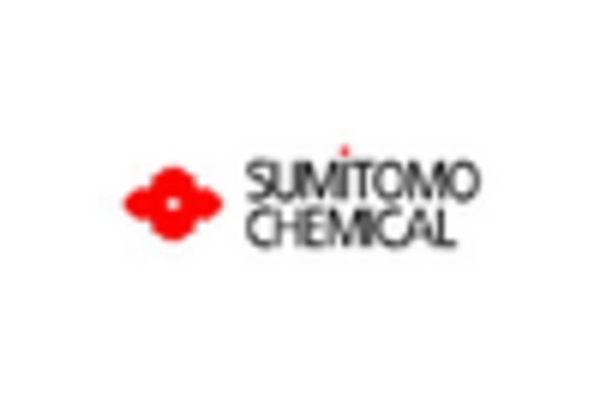-
EXECUTIVE SUMMARY
-
Market Overview
-
Key Findings
-
Market Segmentation
-
Competitive Landscape
-
Challenges and Opportunities
-
Future
-
Outlook
-
MARKET INTRODUCTION
-
Definition
- Research Objective
- Assumption
-
Scope of the study
-
Limitations
-
RESEARCH METHODOLOGY
-
Overview
-
Data Mining
-
Secondary Research
-
Primary Research
- Primary Interviews
- Breakdown of Primary Respondents
-
and Information Gathering Process
-
Forecasting Model
-
Market Size Estimation
- Bottom-Up
- Top-Down Approach
-
Approach
-
Data Triangulation
-
Validation
-
MARKET DYNAMICS
-
Overview
-
Drivers
-
Restraints
-
Opportunities
-
MARKET FACTOR ANALYSIS
-
Value chain Analysis
-
Porter's Five Forces Analysis
- Bargaining Power of Buyers
- Threat of Substitutes
- Intensity
-
Bargaining Power of Suppliers
-
Threat of New Entrants
-
of Rivalry
-
COVID-19 Impact Analysis
- Market Impact Analysis
- Regional Impact
- Opportunity and Threat Analysis
-
POLYMETHYL METHACRYLATE (PMMA) MARKET, BY TYPE (USD BILLION)
-
Extruded Sheets
-
Cast Sheets
-
Pellets
-
Beads
-
POLYMETHYL METHACRYLATE (PMMA) MARKET, BY APPLICATION (USD BILLION)
-
Automotive
-
Construction
-
Signs
-
Displays
-
Electronics
-
Others
-
POLYMETHYL METHACRYLATE (PMMA) MARKET, BY REGIONAL (USD
-
BILLION)
-
North America
- US
- Canada
- Germany
- UK
- France
- Russia
- Italy
- Spain
- Rest of Europe
-
Europe
-
APAC
- China
- India
- Japan
- South Korea
- Malaysia
- Thailand
- Indonesia
-
Rest of APAC
-
South America
- Brazil
- Mexico
- Argentina
- Rest of South America
-
MEA
- South Africa
- Rest of MEA
-
GCC Countries
-
COMPETITIVE LANDSCAPE
-
Overview
-
Competitive Analysis
-
Market share Analysis
-
Major Growth Strategy in the Polymethyl
-
Methacrylate (PMMA) Market
-
Competitive Benchmarking
-
Leading
-
Players in Terms of Number of Developments in the Polymethyl Methacrylate (PMMA)
-
Market
-
Key developments and growth strategies
- New Product
- Merger & Acquisitions
- Joint
-
Launch/Service Deployment
-
Ventures
-
Major Players Financial Matrix
- Sales and Operating
- Major Players R&D Expenditure. 2023
-
Income
-
COMPANY PROFILES
-
Evonik Industries AG
- Financial Overview
- Key Developments
- SWOT Analysis
- Key Strategies
-
Products Offered
-
Chi Mei Corporation
- Financial
- Products Offered
- Key Developments
- Key Strategies
-
Overview
-
SWOT Analysis
-
Altuglas International
- Financial Overview
- Products Offered
- Key Developments
- SWOT Analysis
- Key Strategies
-
Toho Chemical
- Financial Overview
- Products Offered
- Key Developments
- SWOT Analysis
- Key Strategies
-
Industry Co Ltd
-
Mitsubishi Chemical Corporation
- Financial Overview
- Products Offered
- Key Developments
- SWOT Analysis
- Key Strategies
-
LG MMA
- Financial Overview
- Products Offered
- Key Developments
- SWOT
- Key Strategies
-
Analysis
-
BASF SE
- Financial
- Products Offered
- Key Developments
- Key Strategies
-
Overview
-
SWOT Analysis
-
Kolon Industries Inc
- Financial Overview
- Products Offered
- Key Developments
- SWOT Analysis
- Key Strategies
-
Dai Nippon
- Financial Overview
- Products Offered
- Key Developments
- SWOT Analysis
- Key Strategies
-
Toryo Co Ltd
-
Rohm Co Ltd
- Financial Overview
- Products
- Key Developments
- SWOT Analysis
-
Offered
-
Key Strategies
-
Polycasa
- Financial Overview
- Key Developments
- SWOT Analysis
- Key Strategies
-
Products Offered
-
Sumitomo Chemical Company
- Products Offered
- Key Developments
- SWOT Analysis
- Key Strategies
-
Financial Overview
-
Shenzhen
- Financial Overview
- Products
- Key Developments
- SWOT Analysis
-
Jingqiang Plastic Co Ltd
-
Offered
-
Key Strategies
-
SABIC
- Financial Overview
- Key Developments
- SWOT Analysis
- Key Strategies
-
Products Offered
-
APPENDIX
-
References
-
Related Reports
-
LIST OF TABLES
-
LIST OF ASSUMPTIONS
-
NORTH AMERICA POLYMETHYL METHACRYLATE (PMMA) MARKET SIZE ESTIMATES &
-
FORECAST, BY TYPE, 2019-2035 (USD BILLIONS)
-
NORTH AMERICA POLYMETHYL
-
METHACRYLATE (PMMA) MARKET SIZE ESTIMATES & FORECAST, BY APPLICATION, 2019-2035
-
(USD BILLIONS)
-
NORTH AMERICA POLYMETHYL METHACRYLATE (PMMA) MARKET
-
SIZE ESTIMATES & FORECAST, BY REGIONAL, 2019-2035 (USD BILLIONS)
-
TABLE
-
US POLYMETHYL METHACRYLATE (PMMA) MARKET SIZE ESTIMATES & FORECAST, BY TYPE,
-
US POLYMETHYL METHACRYLATE (PMMA) MARKET
-
SIZE ESTIMATES & FORECAST, BY APPLICATION, 2019-2035 (USD BILLIONS)
-
TABLE
-
US POLYMETHYL METHACRYLATE (PMMA) MARKET SIZE ESTIMATES & FORECAST, BY REGIONAL,
-
CANADA POLYMETHYL METHACRYLATE (PMMA) MARKET
-
SIZE ESTIMATES & FORECAST, BY TYPE, 2019-2035 (USD BILLIONS)
-
TABLE 9.
-
CANADA POLYMETHYL METHACRYLATE (PMMA) MARKET SIZE ESTIMATES & FORECAST, BY APPLICATION,
-
CANADA POLYMETHYL METHACRYLATE (PMMA) MARKET
-
SIZE ESTIMATES & FORECAST, BY REGIONAL, 2019-2035 (USD BILLIONS)
-
TABLE
-
EUROPE POLYMETHYL METHACRYLATE (PMMA) MARKET SIZE ESTIMATES & FORECAST,
-
BY TYPE, 2019-2035 (USD BILLIONS)
-
EUROPE POLYMETHYL METHACRYLATE
-
(PMMA) MARKET SIZE ESTIMATES & FORECAST, BY APPLICATION, 2019-2035 (USD BILLIONS)
-
EUROPE POLYMETHYL METHACRYLATE (PMMA) MARKET SIZE ESTIMATES &
-
FORECAST, BY REGIONAL, 2019-2035 (USD BILLIONS)
-
GERMANY POLYMETHYL
-
METHACRYLATE (PMMA) MARKET SIZE ESTIMATES & FORECAST, BY TYPE, 2019-2035 (USD
-
BILLIONS)
-
GERMANY POLYMETHYL METHACRYLATE (PMMA) MARKET SIZE ESTIMATES
-
& FORECAST, BY APPLICATION, 2019-2035 (USD BILLIONS)
-
GERMANY
-
POLYMETHYL METHACRYLATE (PMMA) MARKET SIZE ESTIMATES & FORECAST, BY REGIONAL,
-
UK POLYMETHYL METHACRYLATE (PMMA) MARKET
-
SIZE ESTIMATES & FORECAST, BY TYPE, 2019-2035 (USD BILLIONS)
-
TABLE 18.
-
UK POLYMETHYL METHACRYLATE (PMMA) MARKET SIZE ESTIMATES & FORECAST, BY APPLICATION,
-
UK POLYMETHYL METHACRYLATE (PMMA) MARKET
-
SIZE ESTIMATES & FORECAST, BY REGIONAL, 2019-2035 (USD BILLIONS)
-
TABLE
-
FRANCE POLYMETHYL METHACRYLATE (PMMA) MARKET SIZE ESTIMATES & FORECAST,
-
BY TYPE, 2019-2035 (USD BILLIONS)
-
FRANCE POLYMETHYL METHACRYLATE
-
(PMMA) MARKET SIZE ESTIMATES & FORECAST, BY APPLICATION, 2019-2035 (USD BILLIONS)
-
FRANCE POLYMETHYL METHACRYLATE (PMMA) MARKET SIZE ESTIMATES &
-
FORECAST, BY REGIONAL, 2019-2035 (USD BILLIONS)
-
RUSSIA POLYMETHYL
-
METHACRYLATE (PMMA) MARKET SIZE ESTIMATES & FORECAST, BY TYPE, 2019-2035 (USD
-
BILLIONS)
-
RUSSIA POLYMETHYL METHACRYLATE (PMMA) MARKET SIZE ESTIMATES
-
& FORECAST, BY APPLICATION, 2019-2035 (USD BILLIONS)
-
RUSSIA
-
POLYMETHYL METHACRYLATE (PMMA) MARKET SIZE ESTIMATES & FORECAST, BY REGIONAL,
-
ITALY POLYMETHYL METHACRYLATE (PMMA) MARKET
-
SIZE ESTIMATES & FORECAST, BY TYPE, 2019-2035 (USD BILLIONS)
-
TABLE 27.
-
ITALY POLYMETHYL METHACRYLATE (PMMA) MARKET SIZE ESTIMATES & FORECAST, BY APPLICATION,
-
ITALY POLYMETHYL METHACRYLATE (PMMA) MARKET
-
SIZE ESTIMATES & FORECAST, BY REGIONAL, 2019-2035 (USD BILLIONS)
-
TABLE
-
SPAIN POLYMETHYL METHACRYLATE (PMMA) MARKET SIZE ESTIMATES & FORECAST, BY
-
TYPE, 2019-2035 (USD BILLIONS)
-
SPAIN POLYMETHYL METHACRYLATE (PMMA)
-
MARKET SIZE ESTIMATES & FORECAST, BY APPLICATION, 2019-2035 (USD BILLIONS)
-
SPAIN POLYMETHYL METHACRYLATE (PMMA) MARKET SIZE ESTIMATES & FORECAST,
-
BY REGIONAL, 2019-2035 (USD BILLIONS)
-
REST OF EUROPE POLYMETHYL
-
METHACRYLATE (PMMA) MARKET SIZE ESTIMATES & FORECAST, BY TYPE, 2019-2035 (USD
-
BILLIONS)
-
REST OF EUROPE POLYMETHYL METHACRYLATE (PMMA) MARKET SIZE
-
ESTIMATES & FORECAST, BY APPLICATION, 2019-2035 (USD BILLIONS)
-
TABLE 34.
-
REST OF EUROPE POLYMETHYL METHACRYLATE (PMMA) MARKET SIZE ESTIMATES & FORECAST,
-
BY REGIONAL, 2019-2035 (USD BILLIONS)
-
APAC POLYMETHYL METHACRYLATE
-
(PMMA) MARKET SIZE ESTIMATES & FORECAST, BY TYPE, 2019-2035 (USD BILLIONS)
-
APAC POLYMETHYL METHACRYLATE (PMMA) MARKET SIZE ESTIMATES & FORECAST,
-
BY APPLICATION, 2019-2035 (USD BILLIONS)
-
APAC POLYMETHYL METHACRYLATE
-
(PMMA) MARKET SIZE ESTIMATES & FORECAST, BY REGIONAL, 2019-2035 (USD BILLIONS)
-
CHINA POLYMETHYL METHACRYLATE (PMMA) MARKET SIZE ESTIMATES &
-
FORECAST, BY TYPE, 2019-2035 (USD BILLIONS)
-
CHINA POLYMETHYL METHACRYLATE
-
(PMMA) MARKET SIZE ESTIMATES & FORECAST, BY APPLICATION, 2019-2035 (USD BILLIONS)
-
CHINA POLYMETHYL METHACRYLATE (PMMA) MARKET SIZE ESTIMATES &
-
FORECAST, BY REGIONAL, 2019-2035 (USD BILLIONS)
-
INDIA POLYMETHYL
-
METHACRYLATE (PMMA) MARKET SIZE ESTIMATES & FORECAST, BY TYPE, 2019-2035 (USD
-
BILLIONS)
-
INDIA POLYMETHYL METHACRYLATE (PMMA) MARKET SIZE ESTIMATES
-
& FORECAST, BY APPLICATION, 2019-2035 (USD BILLIONS)
-
INDIA POLYMETHYL
-
METHACRYLATE (PMMA) MARKET SIZE ESTIMATES & FORECAST, BY REGIONAL, 2019-2035
-
(USD BILLIONS)
-
JAPAN POLYMETHYL METHACRYLATE (PMMA) MARKET SIZE
-
ESTIMATES & FORECAST, BY TYPE, 2019-2035 (USD BILLIONS)
-
JAPAN
-
POLYMETHYL METHACRYLATE (PMMA) MARKET SIZE ESTIMATES & FORECAST, BY APPLICATION,
-
JAPAN POLYMETHYL METHACRYLATE (PMMA) MARKET
-
SIZE ESTIMATES & FORECAST, BY REGIONAL, 2019-2035 (USD BILLIONS)
-
TABLE
-
SOUTH KOREA POLYMETHYL METHACRYLATE (PMMA) MARKET SIZE ESTIMATES & FORECAST,
-
BY TYPE, 2019-2035 (USD BILLIONS)
-
SOUTH KOREA POLYMETHYL METHACRYLATE
-
(PMMA) MARKET SIZE ESTIMATES & FORECAST, BY APPLICATION, 2019-2035 (USD BILLIONS)
-
SOUTH KOREA POLYMETHYL METHACRYLATE (PMMA) MARKET SIZE ESTIMATES
-
& FORECAST, BY REGIONAL, 2019-2035 (USD BILLIONS)
-
MALAYSIA POLYMETHYL
-
METHACRYLATE (PMMA) MARKET SIZE ESTIMATES & FORECAST, BY TYPE, 2019-2035 (USD
-
BILLIONS)
-
MALAYSIA POLYMETHYL METHACRYLATE (PMMA) MARKET SIZE ESTIMATES
-
& FORECAST, BY APPLICATION, 2019-2035 (USD BILLIONS)
-
MALAYSIA
-
POLYMETHYL METHACRYLATE (PMMA) MARKET SIZE ESTIMATES & FORECAST, BY REGIONAL,
-
THAILAND POLYMETHYL METHACRYLATE (PMMA)
-
MARKET SIZE ESTIMATES & FORECAST, BY TYPE, 2019-2035 (USD BILLIONS)
-
TABLE
-
THAILAND POLYMETHYL METHACRYLATE (PMMA) MARKET SIZE ESTIMATES & FORECAST,
-
BY APPLICATION, 2019-2035 (USD BILLIONS)
-
THAILAND POLYMETHYL METHACRYLATE
-
(PMMA) MARKET SIZE ESTIMATES & FORECAST, BY REGIONAL, 2019-2035 (USD BILLIONS)
-
INDONESIA POLYMETHYL METHACRYLATE (PMMA) MARKET SIZE ESTIMATES &
-
FORECAST, BY TYPE, 2019-2035 (USD BILLIONS)
-
INDONESIA POLYMETHYL
-
METHACRYLATE (PMMA) MARKET SIZE ESTIMATES & FORECAST, BY APPLICATION, 2019-2035
-
(USD BILLIONS)
-
INDONESIA POLYMETHYL METHACRYLATE (PMMA) MARKET SIZE
-
ESTIMATES & FORECAST, BY REGIONAL, 2019-2035 (USD BILLIONS)
-
TABLE 59.
-
REST OF APAC POLYMETHYL METHACRYLATE (PMMA) MARKET SIZE ESTIMATES & FORECAST,
-
BY TYPE, 2019-2035 (USD BILLIONS)
-
REST OF APAC POLYMETHYL METHACRYLATE
-
(PMMA) MARKET SIZE ESTIMATES & FORECAST, BY APPLICATION, 2019-2035 (USD BILLIONS)
-
REST OF APAC POLYMETHYL METHACRYLATE (PMMA) MARKET SIZE ESTIMATES
-
& FORECAST, BY REGIONAL, 2019-2035 (USD BILLIONS)
-
SOUTH AMERICA
-
POLYMETHYL METHACRYLATE (PMMA) MARKET SIZE ESTIMATES & FORECAST, BY TYPE, 2019-2035
-
(USD BILLIONS)
-
SOUTH AMERICA POLYMETHYL METHACRYLATE (PMMA) MARKET
-
SIZE ESTIMATES & FORECAST, BY APPLICATION, 2019-2035 (USD BILLIONS)
-
TABLE
-
SOUTH AMERICA POLYMETHYL METHACRYLATE (PMMA) MARKET SIZE ESTIMATES & FORECAST,
-
BY REGIONAL, 2019-2035 (USD BILLIONS)
-
BRAZIL POLYMETHYL METHACRYLATE
-
(PMMA) MARKET SIZE ESTIMATES & FORECAST, BY TYPE, 2019-2035 (USD BILLIONS)
-
BRAZIL POLYMETHYL METHACRYLATE (PMMA) MARKET SIZE ESTIMATES & FORECAST,
-
BY APPLICATION, 2019-2035 (USD BILLIONS)
-
BRAZIL POLYMETHYL METHACRYLATE
-
(PMMA) MARKET SIZE ESTIMATES & FORECAST, BY REGIONAL, 2019-2035 (USD BILLIONS)
-
MEXICO POLYMETHYL METHACRYLATE (PMMA) MARKET SIZE ESTIMATES &
-
FORECAST, BY TYPE, 2019-2035 (USD BILLIONS)
-
MEXICO POLYMETHYL METHACRYLATE
-
(PMMA) MARKET SIZE ESTIMATES & FORECAST, BY APPLICATION, 2019-2035 (USD BILLIONS)
-
MEXICO POLYMETHYL METHACRYLATE (PMMA) MARKET SIZE ESTIMATES &
-
FORECAST, BY REGIONAL, 2019-2035 (USD BILLIONS)
-
ARGENTINA POLYMETHYL
-
METHACRYLATE (PMMA) MARKET SIZE ESTIMATES & FORECAST, BY TYPE, 2019-2035 (USD
-
BILLIONS)
-
ARGENTINA POLYMETHYL METHACRYLATE (PMMA) MARKET SIZE ESTIMATES
-
& FORECAST, BY APPLICATION, 2019-2035 (USD BILLIONS)
-
ARGENTINA
-
POLYMETHYL METHACRYLATE (PMMA) MARKET SIZE ESTIMATES & FORECAST, BY REGIONAL,
-
REST OF SOUTH AMERICA POLYMETHYL METHACRYLATE
-
(PMMA) MARKET SIZE ESTIMATES & FORECAST, BY TYPE, 2019-2035 (USD BILLIONS)
-
REST OF SOUTH AMERICA POLYMETHYL METHACRYLATE (PMMA) MARKET SIZE ESTIMATES
-
& FORECAST, BY APPLICATION, 2019-2035 (USD BILLIONS)
-
REST OF
-
SOUTH AMERICA POLYMETHYL METHACRYLATE (PMMA) MARKET SIZE ESTIMATES & FORECAST,
-
BY REGIONAL, 2019-2035 (USD BILLIONS)
-
MEA POLYMETHYL METHACRYLATE
-
(PMMA) MARKET SIZE ESTIMATES & FORECAST, BY TYPE, 2019-2035 (USD BILLIONS)
-
MEA POLYMETHYL METHACRYLATE (PMMA) MARKET SIZE ESTIMATES & FORECAST,
-
BY APPLICATION, 2019-2035 (USD BILLIONS)
-
MEA POLYMETHYL METHACRYLATE
-
(PMMA) MARKET SIZE ESTIMATES & FORECAST, BY REGIONAL, 2019-2035 (USD BILLIONS)
-
GCC COUNTRIES POLYMETHYL METHACRYLATE (PMMA) MARKET SIZE ESTIMATES
-
& FORECAST, BY TYPE, 2019-2035 (USD BILLIONS)
-
GCC COUNTRIES
-
POLYMETHYL METHACRYLATE (PMMA) MARKET SIZE ESTIMATES & FORECAST, BY APPLICATION,
-
GCC COUNTRIES POLYMETHYL METHACRYLATE (PMMA)
-
MARKET SIZE ESTIMATES & FORECAST, BY REGIONAL, 2019-2035 (USD BILLIONS)
-
SOUTH AFRICA POLYMETHYL METHACRYLATE (PMMA) MARKET SIZE ESTIMATES &
-
FORECAST, BY TYPE, 2019-2035 (USD BILLIONS)
-
SOUTH AFRICA POLYMETHYL
-
METHACRYLATE (PMMA) MARKET SIZE ESTIMATES & FORECAST, BY APPLICATION, 2019-2035
-
(USD BILLIONS)
-
SOUTH AFRICA POLYMETHYL METHACRYLATE (PMMA) MARKET
-
SIZE ESTIMATES & FORECAST, BY REGIONAL, 2019-2035 (USD BILLIONS)
-
TABLE
-
REST OF MEA POLYMETHYL METHACRYLATE (PMMA) MARKET SIZE ESTIMATES & FORECAST,
-
BY TYPE, 2019-2035 (USD BILLIONS)
-
REST OF MEA POLYMETHYL METHACRYLATE
-
(PMMA) MARKET SIZE ESTIMATES & FORECAST, BY APPLICATION, 2019-2035 (USD BILLIONS)
-
REST OF MEA POLYMETHYL METHACRYLATE (PMMA) MARKET SIZE ESTIMATES
-
& FORECAST, BY REGIONAL, 2019-2035 (USD BILLIONS)
-
PRODUCT LAUNCH/PRODUCT
-
DEVELOPMENT/APPROVAL
-
ACQUISITION/PARTNERSHIP
-
LIST
-
OF FIGURES
-
MARKET SYNOPSIS
-
NORTH AMERICA POLYMETHYL
-
METHACRYLATE (PMMA) MARKET ANALYSIS
-
US POLYMETHYL METHACRYLATE (PMMA)
-
MARKET ANALYSIS BY TYPE
-
US POLYMETHYL METHACRYLATE (PMMA) MARKET
-
ANALYSIS BY APPLICATION
-
US POLYMETHYL METHACRYLATE (PMMA) MARKET
-
ANALYSIS BY REGIONAL
-
CANADA POLYMETHYL METHACRYLATE (PMMA) MARKET
-
ANALYSIS BY TYPE
-
CANADA POLYMETHYL METHACRYLATE (PMMA) MARKET ANALYSIS
-
BY APPLICATION
-
CANADA POLYMETHYL METHACRYLATE (PMMA) MARKET ANALYSIS
-
BY REGIONAL
-
EUROPE POLYMETHYL METHACRYLATE (PMMA) MARKET ANALYSIS
-
GERMANY POLYMETHYL METHACRYLATE (PMMA) MARKET ANALYSIS BY TYPE
-
GERMANY POLYMETHYL METHACRYLATE (PMMA) MARKET ANALYSIS BY APPLICATION
-
GERMANY POLYMETHYL METHACRYLATE (PMMA) MARKET ANALYSIS BY REGIONAL
-
UK POLYMETHYL METHACRYLATE (PMMA) MARKET ANALYSIS BY TYPE
-
FIGURE
-
UK POLYMETHYL METHACRYLATE (PMMA) MARKET ANALYSIS BY APPLICATION
-
FIGURE
-
UK POLYMETHYL METHACRYLATE (PMMA) MARKET ANALYSIS BY REGIONAL
-
FIGURE 16.
-
FRANCE POLYMETHYL METHACRYLATE (PMMA) MARKET ANALYSIS BY TYPE
-
FRANCE
-
POLYMETHYL METHACRYLATE (PMMA) MARKET ANALYSIS BY APPLICATION
-
FRANCE
-
POLYMETHYL METHACRYLATE (PMMA) MARKET ANALYSIS BY REGIONAL
-
RUSSIA
-
POLYMETHYL METHACRYLATE (PMMA) MARKET ANALYSIS BY TYPE
-
RUSSIA POLYMETHYL
-
METHACRYLATE (PMMA) MARKET ANALYSIS BY APPLICATION
-
RUSSIA POLYMETHYL
-
METHACRYLATE (PMMA) MARKET ANALYSIS BY REGIONAL
-
ITALY POLYMETHYL
-
METHACRYLATE (PMMA) MARKET ANALYSIS BY TYPE
-
ITALY POLYMETHYL METHACRYLATE
-
(PMMA) MARKET ANALYSIS BY APPLICATION
-
ITALY POLYMETHYL METHACRYLATE
-
(PMMA) MARKET ANALYSIS BY REGIONAL
-
SPAIN POLYMETHYL METHACRYLATE
-
(PMMA) MARKET ANALYSIS BY TYPE
-
SPAIN POLYMETHYL METHACRYLATE (PMMA)
-
MARKET ANALYSIS BY APPLICATION
-
SPAIN POLYMETHYL METHACRYLATE (PMMA)
-
MARKET ANALYSIS BY REGIONAL
-
REST OF EUROPE POLYMETHYL METHACRYLATE
-
(PMMA) MARKET ANALYSIS BY TYPE
-
REST OF EUROPE POLYMETHYL METHACRYLATE
-
(PMMA) MARKET ANALYSIS BY APPLICATION
-
REST OF EUROPE POLYMETHYL
-
METHACRYLATE (PMMA) MARKET ANALYSIS BY REGIONAL
-
APAC POLYMETHYL
-
METHACRYLATE (PMMA) MARKET ANALYSIS
-
CHINA POLYMETHYL METHACRYLATE
-
(PMMA) MARKET ANALYSIS BY TYPE
-
CHINA POLYMETHYL METHACRYLATE (PMMA)
-
MARKET ANALYSIS BY APPLICATION
-
CHINA POLYMETHYL METHACRYLATE (PMMA)
-
MARKET ANALYSIS BY REGIONAL
-
INDIA POLYMETHYL METHACRYLATE (PMMA)
-
MARKET ANALYSIS BY TYPE
-
INDIA POLYMETHYL METHACRYLATE (PMMA) MARKET
-
ANALYSIS BY APPLICATION
-
INDIA POLYMETHYL METHACRYLATE (PMMA) MARKET
-
ANALYSIS BY REGIONAL
-
JAPAN POLYMETHYL METHACRYLATE (PMMA) MARKET
-
ANALYSIS BY TYPE
-
JAPAN POLYMETHYL METHACRYLATE (PMMA) MARKET ANALYSIS
-
BY APPLICATION
-
JAPAN POLYMETHYL METHACRYLATE (PMMA) MARKET ANALYSIS
-
BY REGIONAL
-
SOUTH KOREA POLYMETHYL METHACRYLATE (PMMA) MARKET ANALYSIS
-
BY TYPE
-
SOUTH KOREA POLYMETHYL METHACRYLATE (PMMA) MARKET ANALYSIS
-
BY APPLICATION
-
SOUTH KOREA POLYMETHYL METHACRYLATE (PMMA) MARKET
-
ANALYSIS BY REGIONAL
-
MALAYSIA POLYMETHYL METHACRYLATE (PMMA) MARKET
-
ANALYSIS BY TYPE
-
MALAYSIA POLYMETHYL METHACRYLATE (PMMA) MARKET
-
ANALYSIS BY APPLICATION
-
MALAYSIA POLYMETHYL METHACRYLATE (PMMA)
-
MARKET ANALYSIS BY REGIONAL
-
THAILAND POLYMETHYL METHACRYLATE (PMMA)
-
MARKET ANALYSIS BY TYPE
-
THAILAND POLYMETHYL METHACRYLATE (PMMA)
-
MARKET ANALYSIS BY APPLICATION
-
THAILAND POLYMETHYL METHACRYLATE
-
(PMMA) MARKET ANALYSIS BY REGIONAL
-
INDONESIA POLYMETHYL METHACRYLATE
-
(PMMA) MARKET ANALYSIS BY TYPE
-
INDONESIA POLYMETHYL METHACRYLATE
-
(PMMA) MARKET ANALYSIS BY APPLICATION
-
INDONESIA POLYMETHYL METHACRYLATE
-
(PMMA) MARKET ANALYSIS BY REGIONAL
-
REST OF APAC POLYMETHYL METHACRYLATE
-
(PMMA) MARKET ANALYSIS BY TYPE
-
REST OF APAC POLYMETHYL METHACRYLATE
-
(PMMA) MARKET ANALYSIS BY APPLICATION
-
REST OF APAC POLYMETHYL METHACRYLATE
-
(PMMA) MARKET ANALYSIS BY REGIONAL
-
SOUTH AMERICA POLYMETHYL METHACRYLATE
-
(PMMA) MARKET ANALYSIS
-
BRAZIL POLYMETHYL METHACRYLATE (PMMA) MARKET
-
ANALYSIS BY TYPE
-
BRAZIL POLYMETHYL METHACRYLATE (PMMA) MARKET ANALYSIS
-
BY APPLICATION
-
BRAZIL POLYMETHYL METHACRYLATE (PMMA) MARKET ANALYSIS
-
BY REGIONAL
-
MEXICO POLYMETHYL METHACRYLATE (PMMA) MARKET ANALYSIS
-
BY TYPE
-
MEXICO POLYMETHYL METHACRYLATE (PMMA) MARKET ANALYSIS BY
-
APPLICATION
-
MEXICO POLYMETHYL METHACRYLATE (PMMA) MARKET ANALYSIS
-
BY REGIONAL
-
ARGENTINA POLYMETHYL METHACRYLATE (PMMA) MARKET ANALYSIS
-
BY TYPE
-
ARGENTINA POLYMETHYL METHACRYLATE (PMMA) MARKET ANALYSIS
-
BY APPLICATION
-
ARGENTINA POLYMETHYL METHACRYLATE (PMMA) MARKET
-
ANALYSIS BY REGIONAL
-
REST OF SOUTH AMERICA POLYMETHYL METHACRYLATE
-
(PMMA) MARKET ANALYSIS BY TYPE
-
REST OF SOUTH AMERICA POLYMETHYL
-
METHACRYLATE (PMMA) MARKET ANALYSIS BY APPLICATION
-
REST OF SOUTH
-
AMERICA POLYMETHYL METHACRYLATE (PMMA) MARKET ANALYSIS BY REGIONAL
-
FIGURE
-
MEA POLYMETHYL METHACRYLATE (PMMA) MARKET ANALYSIS
-
GCC COUNTRIES
-
POLYMETHYL METHACRYLATE (PMMA) MARKET ANALYSIS BY TYPE
-
GCC COUNTRIES
-
POLYMETHYL METHACRYLATE (PMMA) MARKET ANALYSIS BY APPLICATION
-
GCC
-
COUNTRIES POLYMETHYL METHACRYLATE (PMMA) MARKET ANALYSIS BY REGIONAL
-
FIGURE
-
SOUTH AFRICA POLYMETHYL METHACRYLATE (PMMA) MARKET ANALYSIS BY TYPE
-
FIGURE
-
SOUTH AFRICA POLYMETHYL METHACRYLATE (PMMA) MARKET ANALYSIS BY APPLICATION
-
SOUTH AFRICA POLYMETHYL METHACRYLATE (PMMA) MARKET ANALYSIS BY REGIONAL
-
REST OF MEA POLYMETHYL METHACRYLATE (PMMA) MARKET ANALYSIS BY TYPE
-
REST OF MEA POLYMETHYL METHACRYLATE (PMMA) MARKET ANALYSIS BY APPLICATION
-
REST OF MEA POLYMETHYL METHACRYLATE (PMMA) MARKET ANALYSIS BY REGIONAL
-
KEY BUYING CRITERIA OF POLYMETHYL METHACRYLATE (PMMA) MARKET
-
RESEARCH PROCESS OF MRFR
-
DRO ANALYSIS OF POLYMETHYL
-
METHACRYLATE (PMMA) MARKET
-
DRIVERS IMPACT ANALYSIS: POLYMETHYL
-
METHACRYLATE (PMMA) MARKET
-
RESTRAINTS IMPACT ANALYSIS: POLYMETHYL
-
METHACRYLATE (PMMA) MARKET
-
SUPPLY / VALUE CHAIN: POLYMETHYL METHACRYLATE
-
(PMMA) MARKET
-
POLYMETHYL METHACRYLATE (PMMA) MARKET, BY TYPE, 2025
-
(% SHARE)
-
POLYMETHYL METHACRYLATE (PMMA) MARKET, BY TYPE, 2019
-
TO 2035 (USD Billions)
-
POLYMETHYL METHACRYLATE (PMMA) MARKET, BY
-
APPLICATION, 2025 (% SHARE)
-
POLYMETHYL METHACRYLATE (PMMA) MARKET,
-
BY APPLICATION, 2019 TO 2035 (USD Billions)
-
POLYMETHYL METHACRYLATE
-
(PMMA) MARKET, BY REGIONAL, 2025 (% SHARE)
-
POLYMETHYL METHACRYLATE
-
(PMMA) MARKET, BY REGIONAL, 2019 TO 2035 (USD Billions)
-
BENCHMARKING
-
OF MAJOR COMPETITORS

















Leave a Comment